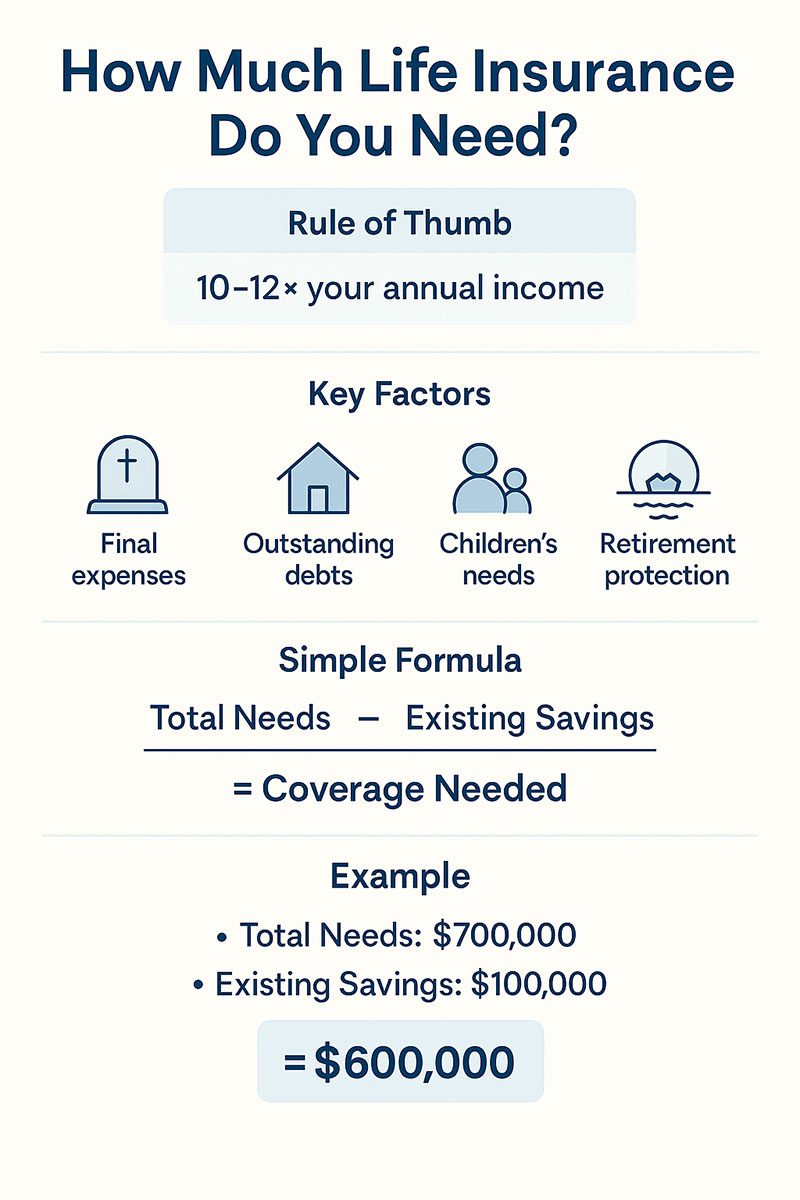How Much Life Insurance Do You Really Need?

How Much Life Insurance Do You Really Need?
Buying life insurance is one of the most important financial decisions you can make, but knowing how much to buy is just as critical as deciding to get coverage at all. Too little, and your family may still struggle financially. Too much, and you may be paying for coverage you don’t need.
This Life Insurance Awareness Month, let’s break down how to find the right balance.
Why the Right Coverage Amount Matters
Life insurance is about protection. It replaces your income, pays off debts, and provides financial security for the people you love. The right amount ensures your spouse, children, or other dependents can maintain their standard of living even in your absence.
Rule of Thumb: 10–12 Times Your Income
A common starting point is to buy coverage equal to 10–12 times your annual income. For example, if you earn $75,000 per year, you may need between $750,000 and $900,000 in coverage.
While this guideline helps, it doesn’t account for individual circumstances. That’s why a personalized approach is best.

The Needs-Based Approach
A needs-based calculation looks at your family’s actual financial obligations and goals. Start with these categories:
- Final expenses – Funeral, burial, or medical costs.
- Outstanding debts – Mortgage, car loans, credit cards, or student loans.
- Income replacement – Number of years your family would need support.
- Children’s needs – Childcare, education, and future milestones.
- Retirement protection – Ensuring a surviving spouse can still retire comfortably.
Once you total these, subtract existing resources (savings, investments, current insurance). The result is the coverage gap you’ll want your life insurance to fill.
Example Scenarios
Young Family with Mortgage and Kids
- Income: $80,000
- Mortgage: $250,000
- College for two children: $200,000
- Final expenses: $20,000
- Total Needs: ~$1 million
- Existing savings: $100,000
- Coverage Needed: ~$900,000
Empty Nesters with Grown Children
- Mortgage nearly paid off
- Goal: Cover final expenses + leave small legacy
- Total Needs: ~$200,000
- Existing savings: $50,000
- Coverage Needed: ~$150,000
Adjusting Over Time
Your insurance needs aren’t set in stone. They often change as life evolves:
- Raising children – higher need for income replacement.
- Paying off debts – coverage amount may decrease.
- Building retirement savings – insurance can shift toward legacy planning.
Review your coverage every few years—or when major life events happen (marriage, children, home purchase, retirement).
Term vs. Permanent Coverage
- Term insurance is often ideal for income replacement during working years.
- Permanent insurance (whole or universal) may be a better fit for estate planning, wealth transfer, or lifelong coverage.
A blend of both can work for many families, offering affordable protection now and guaranteed benefits later.
Final Thoughts
How much life insurance you need depends on your unique goals, debts, income, and family situation. Start with a simple formula, refine it with a needs-based analysis, and revisit it over time.
This Life Insurance Awareness Month, take the time to calculate your family’s true needs. A licensed advisor can help you run the numbers and design a plan that fits your life today—and protects your loved ones tomorrow.
🧑💼 Written by Brent Meyer, founder of SafeMoney.com. With more than 20 years of hands-on experience in annuities and retirement planning, Brent is committed to helping Americans make informed, confident financial decisions.
Disclaimer: The information in this article is for educational purposes only and should not be considered financial, tax, or legal advice. Life insurance products, features, and benefits vary by state and by company. Policy guarantees are subject to the claims-paying ability of the issuing insurer. Always consult with a licensed financial professional before making decisions about coverage.








